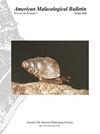博物馆贝壳馆藏的历史DNA:评估干燥小软体动物分子系统学的适用性
IF 0.4
4区 生物学
Q4 MARINE & FRESHWATER BIOLOGY
引用次数: 2
摘要
摘要:自然历史标本是一种宝贵的资源,可以为系统研究和生物多样性发现提供信息,也有助于了解物种丰度和分布随时间的变化。60多年来,太平洋岛屿蜗牛数量和多样性的下降一直是一个主要的保护问题,但只有最大和最鲜艳的蜗牛受到美国濒危物种法案的保护,很少有蜗牛被列为世界自然保护联盟红色名录上的极度濒危物种。像大多数无脊椎动物一样,许多夏威夷蜗牛的保护状况仍需要评估。分子数据对于修正物种限制和理解进化模式和过程具有很高的信息量,但由于多达70%的夏威夷陆地蜗牛已经灭绝,很少有新鲜的样本可以从中提取DNA。为了克服DNA条形码材料的缺乏,我们测试了225到355bp的短DNA片段是否可以从博物馆的蜗牛壳中测序,这些蜗牛壳中含有50多年前收集的干燥组织。66.7%的批次成功测序到短序列(225 bp), 24.2%的批次成功测序到长序列(355 bp)。在博物柜中保存了100多年的蜗牛标本成功测序,为现代生物多样性研究纳入这些材料提供了支持。这项研究的分子数据代表了夏威夷微蜗牛物种的一小部分,这些物种被安置在夏威夷毕夏普博物馆和其他自然历史收藏的数百万个标本中。需要额外的资源和集中的努力来扩大这种方法,以纳入夏威夷需要评估的数百种蜗牛中的更多种类。更广泛地说,在许多自然历史博物馆中,有大量具有代表性的濒临灭绝的太平洋岛屿非海洋蜗牛,它们可能适合用DNA条形码或其他基因组方法进行分子工作。本文章由计算机程序翻译,如有差异,请以英文原文为准。
Historical DNA from Museum Shell Collections: Evaluating the Suitability of Dried Micromollusks for Molecular Systematics
Abstract: Natural history collections are an invaluable resource that can inform systematic studies and biodiversity discovery, and also contribute to understanding changes in species abundance and distributions over time. The decline in abundance and diversity of Pacific Island land snails has been a major conservation concern for more than six decades, but only the largest and most colorful snails are protected under the US Endangered Species act, and few are listed as critically endangered on the IUCN Red List. Like most invertebrates, the conservation status of many Hawaiian land snails still need assessment. Molecular data are highly informative for revising species limits and understanding evolutionary patterns and processes, but with as much as 70% of Hawaiian land snails already extinct, few fresh samples are available from which to extract DNA. To overcome the lack of material suitable for DNA barcoding, we test whether short DNA fragments of 225 to 355 bp can be sequenced from museum snail shells containing dried tissues collected more than 50 years ago. Short DNA sequences (225 bp) were obtained from 66.7% of lots, while longer DNA sequences (355 bp) were successfully sequenced from 24.2% of lots. Snail specimens stored in natural history cabinets for more than 100 years were successfully sequenced, supporting the inclusion of these materials for modern biodiversity studies. Molecular data from this study represents a small proportion of Hawaiian microsnail species housed among the millions of specimens in the Bishop Museum in Hawaii and other natural history collections. Additional resources and focused efforts are needed to scale this approach to incorporate many more of the hundreds of snail species in need of assessment in Hawaii. More broadly, there are large representative collections of endangered Pacific Island non-marine snails in many natural history museums that may be suitable for molecular work, either with DNA barcoding or other genomic approaches.
求助全文
通过发布文献求助,成功后即可免费获取论文全文。
去求助
来源期刊
CiteScore
1.00
自引率
40.00%
发文量
1
审稿时长
>12 weeks
期刊介绍:
The American Malacological Bulletin serves as an outlet for reporting notable contributions in malacological research. Manuscripts concerning any aspect of original, unpublished research,important short reports, and detailed reviews dealing with molluscs will be considered for publication. Recent issues have included AMS symposia, independent papers, research notes,and book reviews. All published research articles in this journal have undergone rigorous peer review, based on initial editor screening and anonymous reviewing by independent expertreferees. AMS symposium papers have undergone peer review by symposium organizer, symposium participants, and independent referees.

 求助内容:
求助内容: 应助结果提醒方式:
应助结果提醒方式:


